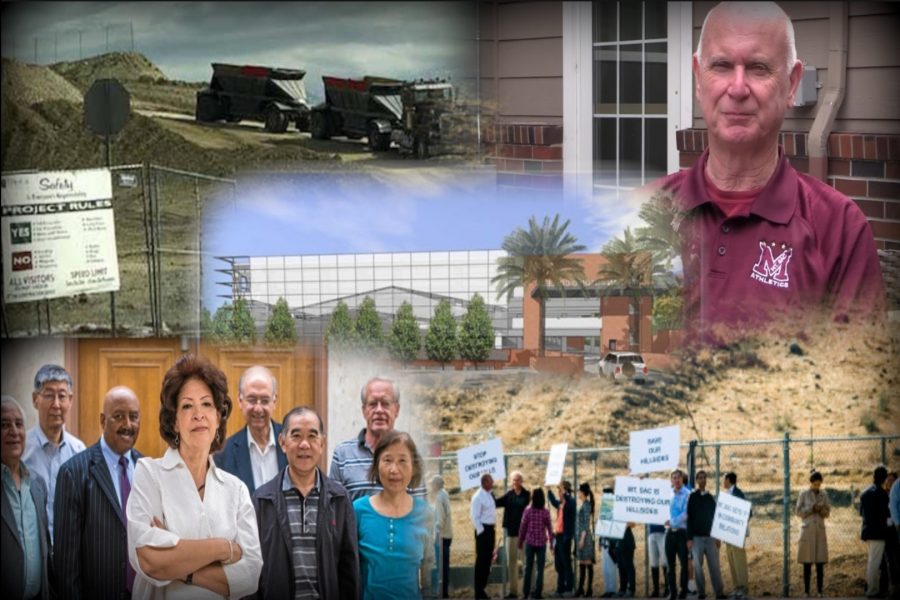For the past few years, Mt. SAC has and continues to face a mountain of lawsuits from the City of Walnut and the United Walnut Taxpayers UWT. The lawsuits are in regards to the construction of several projects the college is trying to build.
“The relationship between the City of Walnut and Mt. SAC was very good until Dr. Scroggins arrived,” Mansfield Collins, UWT board member and 30-year resident of Walnut said. “The city even loaned money to Mt. SAC during the time when it didn’t have funding necessary to complete the construction of the performing arts theater.”
Other community colleges, such as Long Beach Community College, are also building structures within their campuses, but one thing that distinctly differentiates Mt. SAC from them is the college’s indifference toward the city and its residents.
“I think the reason Mt. SAC has issues with the residents as well as the city is because of the administration,” Layla Abou-Taleb, founder and president of UWT said. “Dr. Scroggins and the Board of Trustees do not want to work with the community and the city.”
“The administration at Mt. SAC seems to see themselves as separate and apart from the City of Walnut,” Collins added.
The City of Walnut as well as UWT petitioned four lawsuits against the college, citing a flawed planning process of certain projects by the college such as the Hilmer Lodge Stadium, a five-story parking structure, an 11-acre solar farm and fraudulent use of Measure RR bond money. They also added that the college completely ignored consulting the residents and the city concerning the construction of the projects prior to the structures being funded and launched.
According to Abou-Taleb, the residents filed the first lawsuit against Mt. SAC, which included the parking structure, the solar farm and the stadium in March 2015.
“We sued on the issue of a violation of local ordinances, using bond money when it wasn’t in the approved bond and violation of the California Environmental Quality Act.”
She also added that they are not opposed to the construction of the stadium, but they are against the proposed establishment of the solar farm at a Walnut hillside, as well as the five-story parking structure in Lot A, located at the western edge of the campus that is within 120 feet from single-family homes in the Timberline neighborhood.
“We are not against the parking structure, we were just against the location. We made that very clear,” Abou-Taleb said. “We offered options which we felt were very viable alternatives for Mt. SAC, we even repeatedly went to the Board to try and sit down to have a dialogue.”
According to Collins, what shocked him the most about Scroggins’ approach toward the valid concerns of Walnut residents was when Scroggins told UWT “my lawyers are better than yours” and proceeded to tell them to file their lawsuit against the college.
Collins also stated that Mt. SAC’s administration used a “my way or the highway” approach in resolving the issue. “Mt. SAC needs better governance, better transparency and better accountability because when you do it ‘my way or the highway,’ you’re making people believe that you’re hiding something, or making secret deals.”
Mt. SAC’s ceaseless legal battle over lawsuits submitted by the City of Walnut and the UWT regarding the building of the $87 million stadium project finally reached a Memorandum of Agreement MOA on April 11, 2018.
In exchange to the city dropping the lawsuits, Mt. SAC will have to keep the city up to date about the continued renovations of the stadium project through a task force made up of city and Mt. SAC representatives, and the City of Walnut will also be able to use the stadium by request.
“The city wanted to mend relationships and create partnerships, rather than continue this litigation,” Rob Wishner, City Manager said in an interview with the San Gabriel Valley Tribune. “Mt. SAC is a large institution in our city, and the two government agencies ought to be working together. This establishes some ground rules for moving forward.”
At present, the college agreed to inevitably abandon the construction of the 11-acre solar farm designated for the West Parcel, a busy intersection between Grand Avenue and Temple Avenue, in which 140,000 cubic yards of dirt from the stadium project was to be dumped.
Furthermore, the college also concurred to abandoning the five-story parking structure project from its master plan, after the UWT won the case for a temporary restraining order against it in 2015. The residents argued that the parking structure would cause noise, air pollution, traffic and lower property values.
Currently, the UWT still has a separate pending lawsuit against the college. Walnut residents object to the use of Measure RR bond money, amounting to $353 million they lent the college, for the construction of the stadium, prior to Mt. SAC winning and eventually losing, the bid to host the USA 2020 Olympic Team Trials – Track & Field.
UWT stated that the development of the stadium was not part of the master plan Mt. SAC submitted for the November 4, 2008 ballot, which was subsequently approved with a 69.9 percent supermajority vote by the residents of Walnut.
The group maintains their assertion that the stadium project was not listed in the approved bond money, which is the reason they filed a request for a “Stop Work Order” with the Los Angeles County Superior Court.
“There is nothing in that bond measure that mentions anything about Hilmer Stadium,” Abou-Taleb said.
On April 11, 2018 the Los Angeles County Superior Court Judge Holly E. Kendig issued a tentative ruling of the case, in which she revoked the UWT’s request to get a preliminary injunction.
The injunction, if approved, would have ceased Mt. SAC from using Measure RR bond money for the construction of the stadium. The final ruling for the injunction is set for January 14, 2019 and the UWT is hopeful that they would win the case.
“We feel the merits of our case are very strong,” Abou-Taleb said.
When asked whether the tumultuous relationship between the college and the community can ever be improved, Collins expressed that the UWT wants to maintain a good relationship with Mt. SAC, even after all the lawsuits and litigations, but according to him, a change in the administration is necessary.
“I’m not speaking for the UWT, but as an individual, I am requesting that Dr. Scroggins should resign,” Collins said. “I think that when the resignation takes place, it will wake up the Board of Trustees that they need to think much more transparently and much more collaboratively with the community.”
Abou-Taleb shared the same sentiments as Collins, “We [UWT] will have a better relationship with Mt. SAC once this administration changes,” she said. “Anybody who replaces him, who’s reasonable, will change the dynamic and hopefully we could have what most colleges have – a relationship with the community that they are in.”
Even though the city has settled and will dismiss all lawsuits against the college, except for the one pending case, the actions taken by Mt. SAC sparked questions in the minds of students, faculty, staff and community members regarding how much money was exhausted at the expense of the college.
“The settlement with the first lawsuit cost about $1.4 million in court order payments. We have paid our own attorneys on the order of that same amount,” Scroggins said.
SAC.Media reached out to Doug Jenson, Associate Vice President of Administrative Services, to get a copy of all financial expenses by the college as a result of all the lawsuits, but his office has not gotten back to the staff, as of writing.
The staff also tried connecting with Dr. Scroggins for his side of the story, but he redirected the staff to his lawyers, Walsh & Associates, who have yet to respond for an interview request.
This story will be updated as soon as new vital information is available.







